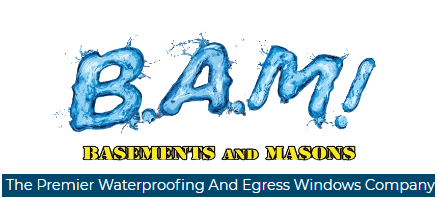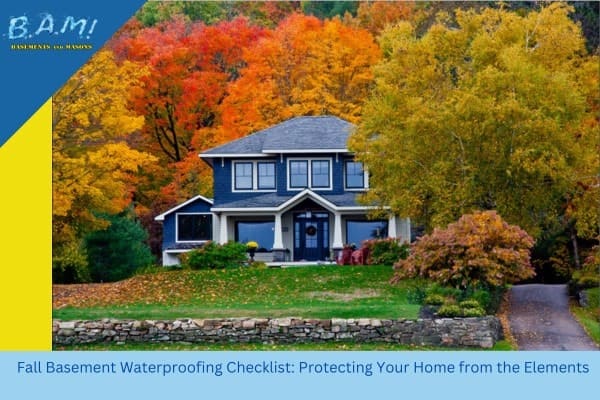As much as we hate to say it, summer is almost over. Where did the time go? That means fall and winter are on their way, shorter days, and colder weather. Fall brings rainy weather and moisture build-up in basements crawl space.
As a homeowner, it’s important to understand what annual fall maintenance your home requires, especially when it is related to wet fall weather. Fall is the perfect time to take a look at your home and prepare for the wetter months ahead. One critical area to focus on is your basement and crawl space. Basement waterproofing and crawl space encapsulation is essential to safeguard your home from potential water damage, mold, and structural issues. From reducing pests to minimizing moisture build-up, these maintenance tips will help save you time, money, and major headaches this fall.
Why Basement Waterproofing Matters
Before diving into the checklist, let’s briefly discuss why basement waterproofing is so important. Your basement is susceptible to moisture intrusion due to its underground location and proximity to soil and groundwater. If left unchecked, this moisture can lead to a different number of problems, including:
Mold Growth: Damp conditions in basements create an ideal breeding ground for mold to thrive, which can negatively impact indoor air quality and also adds health risks to you and your family.
Structural Foundation Damage: Moisture can weaken the foundation and structural integrity of your home, potentially leading to costly repairs. This can cause foundation sinking, foundation cracking, bowing walls and water in the Basement.
Reducing your Home Value: A wet basement can significantly decrease your home’s resale value, making it a less attractive option for potential buyers.
Unusable Space: A damp basement is typically an underused space, limiting its potential for storage, recreation, or additional living areas.
Now that you understand the importance of basement waterproofing, let’s explore the fall checklist to ensure your basement stays dry and your home remains protected.
Fall Basement Waterproofing Checklist
1. Inspect Your Basement for Existing Issues
Look for signs of water damage, such as damp spots, water stains, or cracks in the walls or floor. Check for any signs of mold or mildew growth. Ensure that your sump pump is functioning correctly.
2. Clean Your Gutters and Downspouts
Remove leaves and debris from your gutters and downspouts to prevent water overflow and potential foundation damage. Clean your home’s gutters, make sure the downspouts are pointed away from the home. If water pools around the exterior walls, it can easily seep inside and even damage your home’s foundation over time. Ensuring you keep up good gutter and downspout maintenance each year can help protect your home and its foundation against water damage in the fall and winter.
3. Grade Your Landscape Away from the House
Ensure that the ground slopes away from your home’s foundation to divert water away from your basement walls. If the soil around the foundation doesn’t drain properly, it could cause serious foundation issues with time. Proper landscaping and grading are the first step toward preventing leaks into the foundation.
4. Seal Basement Cracks
Inspect and seal any visible cracks or gaps in your basement walls or floor using an appropriate waterproof sealant.
5. Check Window Wells and Windows
Ensure that window wells are properly covered and sealed to prevent water from seeping into your basement. Take care of windows. Basement windows are easy to forget because they are small and set higher along the basement wall. However, they can be a major culprit for letting cold air into your home. Use plastic window film to cover them and keep the cold air at bay.
6. Invest in Interior Waterproofing
We can’t stress enough how important waterproofing is to the health and dryness of your crawl space basement. From controlling moisture to preventing floods, there are many solutions that can create the perfect basement environment. Consider the following:
Interior drainage – These systems arrest water that enters the basement walls/floor and directs it to the sump pump.
Basement sump pump – Coupled with interior drains, a properly functioning sump pump ejects water that seeps through or gets inside through snow melts or flooding.
Test your sump pump to ensure it’s working correctly. If necessary, consider a battery backup system to keep it operational during power outages.
7. Inspect Plumbing and HVAC Systems
Check for leaks in your plumbing or HVAC systems, as they can contribute to moisture problems in the basement. Before the temperatures drop, ensure your home’s pipes are working well, any leaks are identified and fixed, and any standing water removed immediately. Reducing drafts throughout the home can help lower your energy bills and guard against water damage.
8. Dehumidify Your Basement
Use a dehumidifier to maintain optimal humidity levels in your basement, discouraging mold growth. A Dehumidifier unit dries out the basement air and prevents secondary moisture problems like wood rot, peeling wall paint, and mold growth.
9. Store Items Off the Floor
Elevate valuable or sensitive items off the basement floor to protect them from potential water damage.
Professional Basement Waterproofing Assistance
If you discover significant issues during your fall basement inspection or if you’re unsure about any aspect of basement waterproofing, it’s wise to consult with a professional waterproofing contractor. They can provide expert guidance and recommend the best solutions to keep your basement dry and your home safe.
Water damage can impact your home’s foundation as well. Schedule a free estimate from our trained specialists to ensure no cracks or leaks are identified. If foundation damage is discovered, fix them before temperatures change and winter weather can make the problem worse. For basements and crawl spaces, professional waterproofing can help reduce moisture build-up, minimize pests, and protect against rainy fall weather.
Call The Best BAM basements
Allow the basement waterproofing and crawl space experts at BAM Basements and Masons to help you. We are one of the most sought-after names when it comes to basement waterproofing in and around Des Moines. Our team has many years of experience and in-depth knowledge about keeping the basement free from moisture and humidity. Therefore, we can suggest the right method for your home.
All our basement waterproofing techniques come at bargain basement pricing, and we ensure the timely completion of each of the projects. To know more about basement waterproofing and get a free estimate, please feel free to call us!


